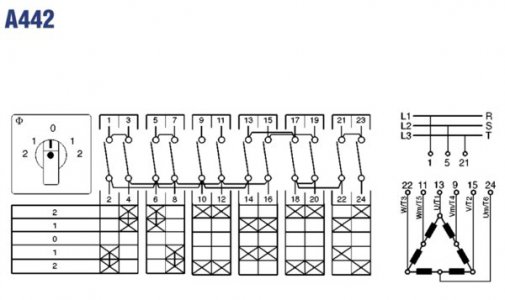- Joined
- Jan 22, 2017
- Messages
- 90
I hope I'm doing the right thing. I've drifted from asking about general wiring of the the whole machine to looking at the wiring inside my motor, so I've started a new thread....
The motor is three-phase, 415V.
The switch is a Kraus & Naimer A442 and a bit of digging on the internet showed me how it's wired. If I've understood it correctly, in position "1" the three live feeds go to the corners of the delta (T1, T2, T3).
In position "2" the three live feeds go to the middle of arms of the delta (T4, T5, T6) and the corners are shorted together so that the configuration is two Wye circuits, in parallel.
From this, am I correct in assuming that the motor will run from 240V (3 phase from a VFD) in position "2" - but with only about half the power - something akin to the performance of the motor running from 415V and the switch in position "1"?
I presume, if this is correct, that to get the machine to run at full tilt, I either need to find a 415V power source, have the motor rewound professionally, or fit a substitute motor?
Any advice, folks?
Kind wishes,
Nick


The motor is three-phase, 415V.
The switch is a Kraus & Naimer A442 and a bit of digging on the internet showed me how it's wired. If I've understood it correctly, in position "1" the three live feeds go to the corners of the delta (T1, T2, T3).
In position "2" the three live feeds go to the middle of arms of the delta (T4, T5, T6) and the corners are shorted together so that the configuration is two Wye circuits, in parallel.
From this, am I correct in assuming that the motor will run from 240V (3 phase from a VFD) in position "2" - but with only about half the power - something akin to the performance of the motor running from 415V and the switch in position "1"?
I presume, if this is correct, that to get the machine to run at full tilt, I either need to find a 415V power source, have the motor rewound professionally, or fit a substitute motor?
Any advice, folks?
Kind wishes,
Nick


